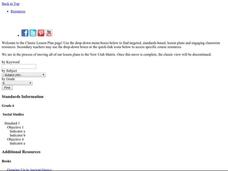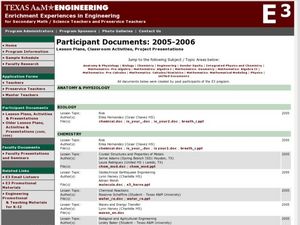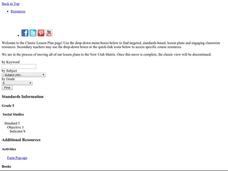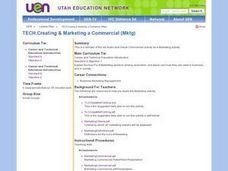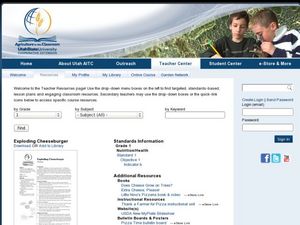Curated OER
Understanding MyPlate
Sixth graders recognize how using the food pyramid can add to their good health practices. In this food pyramid lesson, 6th graders build a 3-D food pyramid illustrating the desired amount of each food group.
Curated OER
Hand Washing: I can handle it!
Sixth graders examine microorganisms. In this germs lesson, 6th graders observe and record data on the positive and negative aspects of microorganisms. Students complete activities, view a film, and explore websites.
Curated OER
Microbe Experimentation
Sixth graders conduct a microbe experiment. In this microbe lesson, 6th graders develop an experiment with micro-organisms, complete the associated worksheet, and complete a table showing the results.
Curated OER
Ancient Mediterranean Lands: Greece
Sixth graders explore the processes developed by the Ancient Greeks, particularly olives and olive oil. In this Greek culture and inventions lesson, 6th graders read an article and design a flap book. Students collect the olive oil...
Curated OER
From Foraging to Farming
Students experience the difficulty that goes along with foraging for food. In this lesson on the importance of modern agriculture, students simulate how there simply is not enough food and water for everyone when agricultural means are...
Curated OER
Ancient Civilizations
Sixth graders complete map-work in order to understand the progression of hunter-gatherer societies. In this hunter-gatherer lesson plan, 6th graders label maps with the Equator, the Tropics, and the vegetation. They complete associated...
Curated OER
Analyzing Birds and Planes
Students find a variety of topics and subjects in this instructional activity. In the math section of this instructional activity, students graph linear equations and analyze their data. They solve one and two step equations to find the...
Curated OER
Caps for Sale/Color Words
Students read the book "Caps for Sale." Students model reading a sentence and using one color cap and the color word (written in its color). They match the color word (written in its color) to the correct color hat.
Curated OER
BUS: Farming: It's A Fact (Ag)
Students create two different types of graphs from the information in the "Farm Facts" booklet (i.e., bar graph, pie chart, etc.). They calculate where your food dollars are spent (on and off farm).
Curated OER
What is Biotechnology
Young scholars discover the concept of biotechnology. For this biotechnology lesson, students explore the history of biotechnology and its implications today.
Curated OER
The Big Apple
Students study the buying and selling market and how prices are determined for an agricultural product. In this competitive market instructional activity, students study how prices are determined in a market by studying the forces of...
Curated OER
Food Systems Feed the World
Fifth graders explore nutrition by viewing video clips discussing world hunger. In this malnutrition lesson, 5th graders discuss the reasons people cannot afford food in rural areas and read assigned text discussing our agriculture...
Curated OER
Where Does It Come From?
Fifth graders explore free trade. In this free trade lesson plan, 5th graders discover which commonly found products are made in the United States and which originate from other countries. Students explore which countries are better at...
Curated OER
Creating & Marketing a Commercial
Young scholars explain the four P's of Marketing (product, pricing, promotion, and place) and how they are used in business and in society. They produce the remake of an old audio and visual commercial activity as a marketing activity.
Curated OER
Science: Flight Aerodynamics
Students apply the principles of aerodynamics by constructing styrofoam airplanes. By using simple tools and materials, they improve their spatial visualization abilities while increasing motor skills. After small groups of students...
Curated OER
High Tech Food
Students view videos, read, and fill in charts about agriculture production. In this agriculture lesson plan, students complete these agriculture activities and explore careers in agriculture.
Curated OER
Favorite Foods
Students explore human health by reading agricultural books. In this dietary habit instructional activity, students discuss the foods we eat everyday and read two books about our human diets. Students identify the uses our body has for...
Curated OER
Pre-K Appetizer
Students explore health by identifying positive eating habits. In this dietary lesson, students read several books about eating well and making wise food decisions. Students view the food pyramid on the USDA website and discuss the...
Curated OER
Animals and Environments
Students listen to stories and identify animals and their young. In this animals lesson, students view videos about farm animals and create illustrations to show how animal babies change over time. Students discuss...
Curated OER
Exploring Texture In the Garden
Students explore the garden environment. In this garden environment lesson plan, students investigate the needs and parts of a plant. Students discover the differences between fruits and vegetables while creating their own garden.
Curated OER
Four Seasons
Students investigate the four seasons in a year. In this seasons lesson, students explore the weather during each season. Students illustrate each season with pictures.
Curated OER
What's Your Favorite Season?
Students explore earth science by creating illustrations in class. In this four seasons lesson, students identify the four different types of weather that take place during the year and read the books Harvest Year and Snow Comes to the...
Curated OER
Who's Who?
Students explore biology by identifying animals and their environments. In this animal characteristic lesson, students read assigned text about farm animals, how they are raised, and what they are used for in our society. Students view a...
Curated OER
Exploding Cheeseburgers
Students identify the components of a healthy diet. In this nutrition lesson, students discuss the parts of a cheeseburger and identify the food groups the cheeseburger is a part of. Students discuss how carbohydrates and proteins are...



